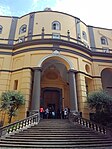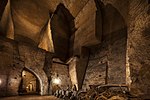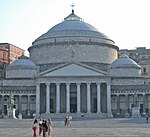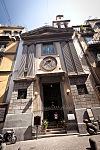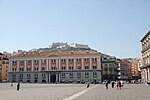The Nunziatella Military School of Naples, Italy, founded November 18, 1787 under the name of Royal Military Academy (it.: Reale Accademia Militare), is the oldest Italian institution of military education among those still operating. Its building, familiarly called "Red Manor" (it.: Rosso Maniero), and the adjacent church of the Santissima Annunziata, is an architectural monument of the city of Naples.
Located in Pizzofalcone in via Generale Parisi, 16, it was a place of high military and civilian training since its foundation, and had among its teachers and students the likes of Francesco de Sanctis, Mariano d'Ayala, Carlo Pisacane, Guglielmo Pepe, Enrico Cosenz and even a king of Italy, Vittorio Emanuele III, and a Viceroy of Italian East Africa, Prince Amedeo, Duke of Aosta.
Among the many alumni of prestige, high degrees of the Armed Forces, including one Director of the European Union Military Committee, two Chiefs of Defence Staff, five Army Chiefs of Staff, two Navy Chiefs of Staff, one Air Chief of Staff, two Commanders General of the Guardia di Finanza (and two Vicecommanders), two Commander General of the Carabinieri (and eight Vicecommanders) and two Directors-General of the Information Services need to be cited. As for the civilian alumni, three Prime Ministers, 14 Ministers, 13 senators and 11 deputies of the Kingdom of the Two Sicilies, the Kingdom of Italy and the Italian Republic, a President of the Constitutional Court, as well as representatives of absolute importance of the cultural, political and professional Italian and international landscape, including a winner of the prestigious Sonning Prize, awarded to the most important European intellectuals, have to be remembered.
The flag of the school is decorated with a Gold Cross of Merit of the Carabinieri, and a bronze medal at the Valor of the Army. Its former students have earned 38 gold medals, 147 silver medals and 220 bronze medals for military valor; 1 gold medal for civil valor; and numerous other awards for valor. A total of 21 of them are decorated with the Military Order of Italy and 56 of the Order of Merit of the Italian Republic.
For its role in the last three centuries "in the field of higher education, as a academic, social and economic motor for Italy and all the Mediterranean countries linked to it", on February 22, 2012 it was declared "Historical and cultural heritage of the Mediterranean countries" by the Parliamentary Assembly of the Mediterranean. The School is also the winner of the Cypraea Prize for Science (1994) and the Mediterranean Award awarded by the Fondazione Mediterraneo (2012).The way as youth is here educated has no equal in the whole of Europe. Philosophy, patriotism, and experience would not have been able to conceive or carry more noble institution to form the temperament, reason, heart and all the knowledge required to military.

